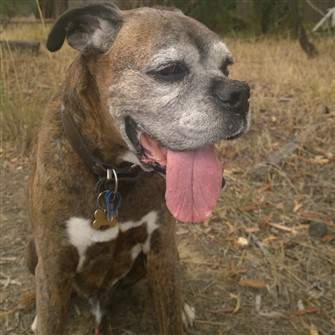Boxer Dog Intelligence
Disclosure: Some of the links to the products below are affiliate links. This means that, at no cost to you, we will earn an affiliate commission if you click through the link and finalize a purchase. The commission helps keep this site running.
Overview
If you have a Boxer dog, no doubt he/she seems super smart. You know your Boxer is more than aware of what’s going on, you’d swear that he knows what you’re whispering from across the room and he catches on to things very quickly.
In fact, if you feel that having your Boxer is very similar to having a child, you’re not far off in your thinking. Recent studies on this are quite surprising. So, why doesn’t this breed rank at the top of the list in canine intelligence? The question of canine intelligence and breed specific intelligence is not without controversy. This section will explore this topic as we discuss:
- How smart Boxer dogs are compared to humans
- Brain Neutron Comparison
- Emotional Capacity
- Where this breed ranks in the intelligence of dog breeds and reasons why this ranking is misleading
- Things you can do to allow your Boxer dog to live to his/her potential
Bella, photo courtesy of Eileen Kelley
Canine Intelligence Compared to Humans
This is such an interesting topic and confirms what so many dog owners already know: that having a dog is like having a child.
Most researchers agree that canines are as smart as a 2 to 3-year-old human, with the ‘average’ dog having the intelligence equivalence of a 2.5-year-old toddler.
And this is really saying something.
If you look at the skill set of both 2-year-olds and Boxer dogs, you’ll see a lot of similarities.
At this level, there is enjoyment of using senses and motor skills, with a high curiosity in regard to objects and events. Problems are solved via trial and error (more ahead on how to develop this more with your Boxer).
Intelligence shows via logical reasoning. There is initiative to produce sounds during play (dogs will squeeze or shake toys to produce squeaks or voices with voice-activated toys), and most importantly, an understanding of words.
Word comprehension
is a crucial factor in determining intellect. A 2-year-old child understands, on average, 165 words which matches the comprehension of the ‘typical’ dog. However, ‘high achiever’ canines can understand 250 and if an owner really works on this with their Boxer, a dog can understand many more.
Other factors taken into account to rank intelligence include:
Memory skills
– Canines have both short and long term memory. Short-term can be as little as 5 minutes, however once something transfers into long-term (often with repetition), it can last a lifetime.
Awareness- This is part of the intelligence skill-set that canines have in regard to being cognizant of their surroundings. This is limited as a puppy and one of the reasons why a very young Boxer dog may seem oblivious to many noises, being handled and such… but as he matures and becomes more mindful, he may express intolerance for these things.
Beginning at the age
of 5 to 6 months old, dogs are quite aware of their world, however an interesting facet of this is that Dr. Stanley Coren, who published the famous book The Intelligence of Dogs (more ahead), believed that canines cannot move past the level of 3-year-old human intelligence, due in part to not being able to pass the ‘Mirror Test’.
This is simply a test to see if a dog can recognize his own reflection and is said, by many, to be the most sophisticated aspect of consciousness, with only humans, chimpanzees, orangutans, gorillas and dolphins able to pass this test.
Humans develop this ability anywhere between the early age of 18 months and sometimes as late as 3 years old.
Dr. Coren claimed that no dogs – no matter the breed or its personal intelligence level – is able to do this.
He firmly believed that dogs will either ignore the image or believe it is another animal.
This is, however, debated. Biologist Marc Bekoff of the University of Colorado believes that since the refection does not have its own scent, that a dog then interprets the reflection as not being real. He suggests that if dogs were tested to recognize their own scent instead of their own image, that they would pass with flying colors.
Perception
– How one perceives his world is telling in regard to intelligence and canines surpass humans in some of these aspects, including the combination of smell and hearing. They are lacking in vision, however.
Interestingly, it is proven that canines are aware of the Earth’s magnetic pole; something humans simply cannot do without assistance.
Studies of Magnetoreception in canines
have proven that if a dog is off leash, has no distractions and if the magnetic field is calm, he/she will align their body north to south when going to the bathroom.
While it is unclear why this is done, it was proven using 70 dogs comprised of 37 breeds over the course of 2 years.
"That look I get before I leave for work"
Rosco Tiberius Workman (3 years 3 months), photo courtesy of Janean Workman
Social cognition
– There are 2 interesting aspects of this. The first is social understanding, in other words, knowing one’s social status at any one given time. It is said that canines greatly exceed humans in this intelligence aspect, knowing almost immediately where they rank in their ‘pack’.
The other element is the ability to pick up on social cues.
Studies on this were done, testing dogs to see if they could spot a treat’s hiding spot not by their owner’s words, but via subtler cues such as facial expression and minute gestures; and once again canines proved how smart they were, succeeding quite often.
This is one reason why owners should be very aware of the non-verbal cues that they are sending out, that a Boxer dog can pick up on. This includes an owner’s behavior before leaving the house, which can set off separation anxiety well before a Boxer dog is left home alone.
Problem Solving – This involves the intelligence to work out a problem. You may witness this if your Boxer works hard to figure out how to open a cabinet door that his food is hidden behind. And you can help a Boxer improve his thinking skills with puzzle games (more ahead).
Summary of Boxer Dog Intelligence Compared to Humans
When you take all of these things and put them together, general consensus is that the ‘typical’ canine family member will be at the very least as smart as a 2-year-old and can be as smart as a 3-year-old.
So, while the Boxer breed may not be listed as the most intelligent dog in the world (and this too is debated- more ahead), he or she is most assuredly, very smart.
Number of Neurons
There are countless ways to interpret how smart one mammal is over another. And most experts do not agree in the ranking of animal intelligence.
Jab, photo courtesy of Philip & Melanie Lipani
An interesting method that can tell a bit of the picture is to look the number of neurons (cells that transmit
information in a mammal’s nervous system to interpret stimuli from its environment and behave accordingly) in the brain.
So, just for fun, let’s take a look at how your Boxer dog compares to other animals and to us humans in this regard:
Mammal & # of Neurons in the Brain
- Human 19,000,000,000–23,000,000,000
- Chimpanzee 6,200,000,000
- Squirrel monkey 430,000,000
- Cat 300,000,000
- Dog 160,000,000
- Hedgehog 24,000,000
- Mouse 4,000,000
Well, it is at least comforting to know that our Boxers are smarter than a hedgehog and that there’s a reason why your cat (if you have one) appears to have one up on your Boxer.
Emotional Intelligence
Before we dive into dog breed specific intelligence and where the Boxer ranks with that, let’s take a look at a final method of classifying intelligence.
It is in regard to the type of emotions that can be felt and expressed. Studies of emotional capabilities in canines
tell us that with both humans and dogs alike, not all emotions are present at birth. In fact, both newborn babies and newborn puppies only have one: Excitement.
As they mature, the ability to feel and express more emotions develop and they do so in a particular order: Excitement, distress, contentment, disgust, fear, anger, joy, suspicion, shyness, affection and love. By the one-year mark in humans all of these emotions are present. With medium sized breeds such as the Boxer dog, these are all present by the 5 to 6-month mark.
And this is where things split off. Humans continue on to develop: Shame, pride, guilt and contempt. Studies suggest that dogs do not reach that point.
It’s a bit hard to believe that Boxer dogs (or any other breed) do not have the ability to feel guilt; they certainly play that off well after ripping apart an owner’s favorite pillow. And pride? Many appear to walk proudly and to that end, the AKC breed standard mentions the word ‘proud’ in regard to the Boxer dog: "The gait is firm yet elastic, the stride free and ground covering, the carriage proud".
So, what does this mean? Well, there are 3 things to note:
1)
Pride develops at the 3-year mark in humans. Studies show that canines stop emotional development at ‘approximately’ the 2.5-year mark equivalent. The key here is the word ‘approximately’, which means that dogs can develop further out and these figures are rough estimates.
2)
Dogs are proven to feel shy (it is the 8th emotion to develop), and shyness can be seen as being the opposite of confident. Therefore, one could argue that if a dog is not feeling shy, he is feeling confident. There is a very fine line of distinction between confidence and pride. Studies tell us that a dog can feel the former but not the latter. With pride, a person crosses the line of feeling good about himself and ego starts to play a role.
3)
In regard to a Boxer dog looking or acting guilty after doing something wrong, this is not in an owner’s imagination. Canines do
change facial expression and body stance in reaction to something… however, studies suggest that the ‘something’ is not something that the dog did wrong, but rather how his owner behaves/speaks/act in reaction to it.
Where the Boxer Breed Ranks in Intelligence
In regard to how smart are Boxer dogs in comparison to other breeds, just about every owner wants to know this and then is shocked to find out the answer.
However, it must be noted that there is only
1 source used for this and it is very controversial. We touched one of Dr. Coren’s beliefs previously (in regard to the ‘Mirror Test’) and he is the professor from the University of British Columbia in Vancouver who published a book called The Intelligence of Dogs back in 1994. It was updated in 2006. His goal was to find out how smart each breed was.
You might think that for such an important topic and for a resource that so many would look to (his idea was breakthrough and he had no competition), that extensive and impeccable work would be put into this.
However, there were several limits to how this was done, including:
1.
Out of all of the ways to measure intelligence, only the element of ‘work and obedience’ was taken into account.
2.
Dr. Coren did not see or interact with any dogs.
3.
An extremely small group of people ranked the breeds: 199 trial judges from the US and Canada, via evaluation sheets that were mailed out to them and their answers were based only what they saw in the show ring.
Intelligence Classifications:
131 breeds were ranked from #1 (most intelligent) to #80 (least). 52 of the breeds tied. In these rankings of #1 through #80, there are 6 levels:
- Brightest Dogs
- Excellent Working Dogs
- Above Average Working Dogs
- Average Working/Obedience Intelligence
- Fair Working/Obedience Intelligence
- Lowest Degree of Working/Obedience Intelligence
The Results:
The Boxer dog placed at #48, in the Average Working/Obedience Intelligence group, tying with the Great Dane.
While many owners would argue that this is not a fair representation, this does -at least - place the Boxer above the 2 classes of ‘Fair Working/Obedience Intelligence’ and ‘Lowest Degree of Working/Obedience Intelligence’.
Other breeds in this ‘Average’ group include dogs known for being highly intelligent, including the Siberian Husky, Shiba Inu, Akita, Alaskan Malamute and Greyhound.
Ways to Help Your Boxer Dog Develop to His/her Potential
The capacity
to be very smart is there. However, dogs will only learn so much on their own, via their experiences.
A dog’s world is as small or large as an owner allows it to be. And the brainpower of a Boxer dog of any age can indeed grow.
There are things you can do to help your Boxer develop to his natural potential:
Jasper, 14 years old
Photo courtesy of Matt
1) Offer sense stimulation.
Allow a Boxer to work his senses: hearing, scent and vision. Hide treats and encourage him to sniff them out. Bring him to new places and allow him to hone in on all of the stimuli.
2) Teach your Boxer dog more words.
Just being part of the family, a dog will pick up about 165 words by the time he reaches maturity (2 years old for the Boxer). However, a Boxer dog can be much smarter than that! Your dog has the capacity to learn double that amount. Easily.
Start with laying out 3 objects. Pick up each one and say its name out loud. Repeat his over, enunciating clearly. Then, pick one object, call out its word and encourage your Boxer to mouth or paw it. If he gets it right, offer an immediate treat.
Repetition is key here, it just has to be done enough times that it moves from his short term memory to long term. Once he learns those 3, do 3 more. There really is no limit here. There’s a Border Collie that knows over 1000 words. (though, we must admit this is the breed that ranked #1 in Dr. Cohen’s book). No worries, your Boxer can learn half that amount and be considered super smart.
3) Have your Boxer dog engage his brain.
The more your Boxer thinks and the more the gears in his mind spin, the smarter he’ll be. Play games in which you hide a treat under 1 of 3 cups, but do not verbally say anything; work on teaching your Boxer to pick up on cues (as discussed above) to know where to look based on your small gestures of heads nods, shoulder shrugs or facial expressions.
There’s also some fantastic canine puzzle games in which your Boxer (taught by you) learns to slide panels and nose
levers to move obstacles in order to finally reach hidden treats. These are great games that not only can make your Boxer dog smarter, but are also fantastic ways to spend quality bonding time.
Have You Seen?
Boxer Dog Eye Gook
- What this breed can tend to have thick eye discharge and how to keep the eyes clean.






